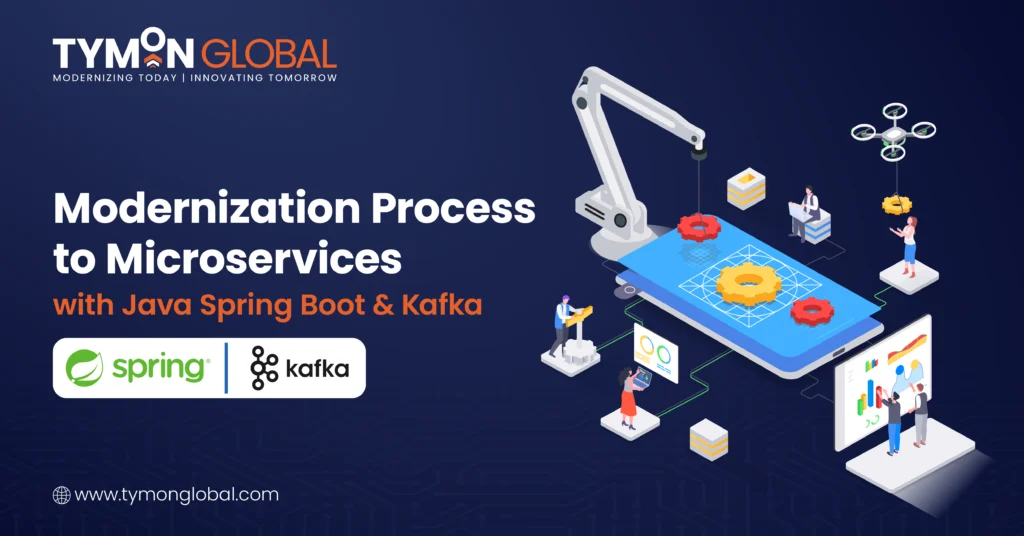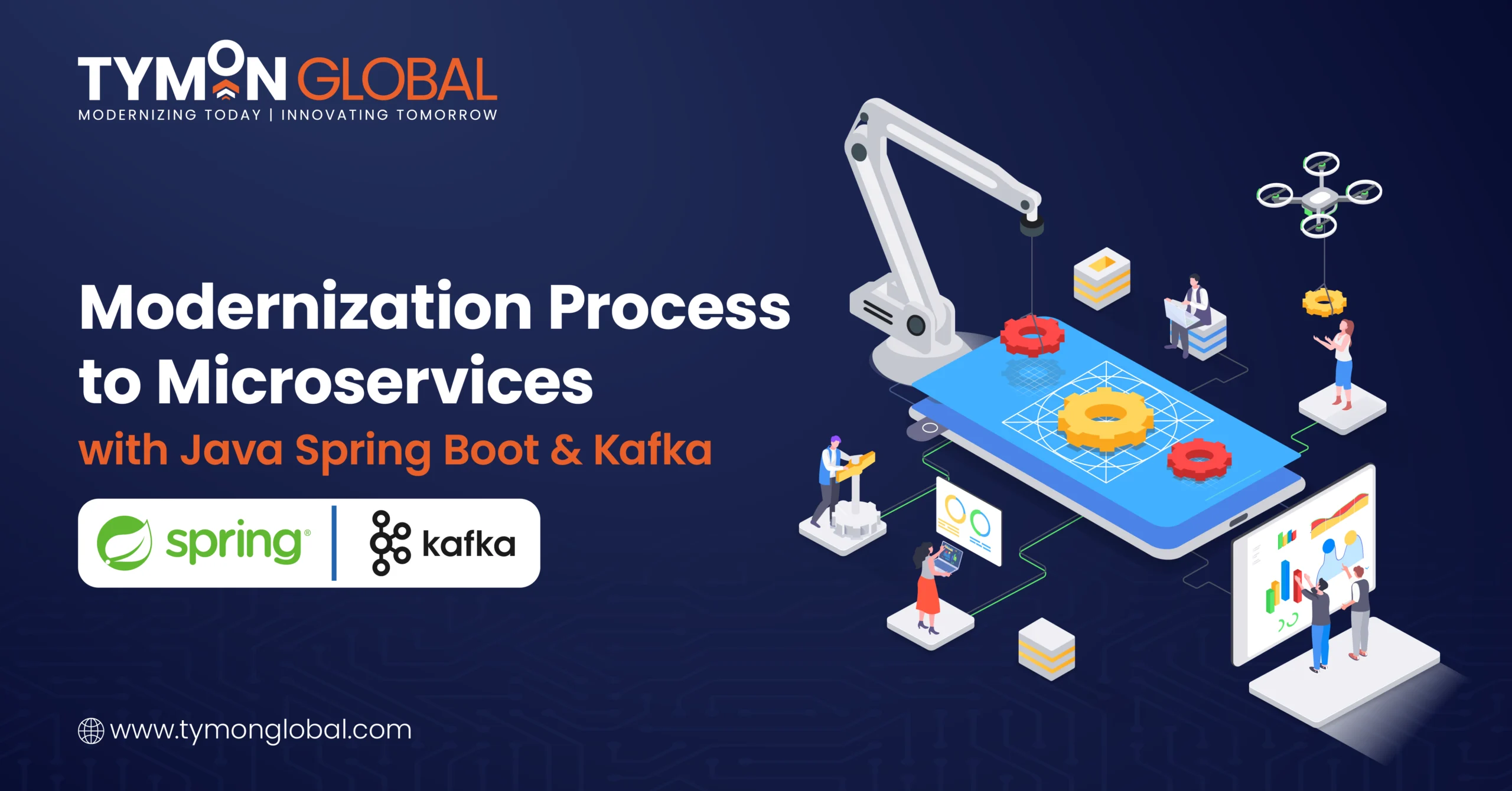
In the rapidly evolving tech landscape, organizations are increasingly transitioning from monolithic applications to microservices architecture to enable scalability, flexibility, and faster innovation cycles. Tymon Global, a leader in IT solutions, helped a client modernize their system and migrate to a microservices architecture using Java Spring Boot, Kafka, and Microsoft Copilot. The outcome was a seamless transition that resulted in enhanced scalability, faster development cycles, and improved security.
This case study outlines the modernization process, focusing on the technical aspects of using Spring Boot, Kafka, Microsoft Copilot, and GitHub to implement a robust microservices-based architecture.
Introduction
The microservices architecture market is expanding rapidly, with Gartner predicting that by 2025, 80% of enterprises will adopt this model for its scalability and agility. However, shifting from a monolithic system to microservices requires a solid foundation and modern development practices.
Tymon Global specializes in guiding businesses through this transformation, using Java Spring Boot, Kafka, Spring Security, Microsoft Copilot, and other cutting-edge technologies. This case study discusses how Tymon Global leveraged these technologies to help a client modernize their infrastructure and unlock operational efficiencies.
Challenges and Issues to Solve
The client, a large enterprise, faced significant issues with their legacy monolithic system, including:
- Scalability limitations: The system could not handle the increasing demand from growing business activities.
- Slow deployment cycles: The monolithic structure slowed down the development of new features and releases.
- Inflexibility: The system’s rigid design made it difficult to introduce new technologies and processes.
- Security concerns: Ensuring secure communication and data protection across services was becoming challenging.
Tymon Global was tasked with guiding the client through the transition to microservices architecture. The approach included integrating Spring Boot, and Kafka, and leveraging Microsoft Copilot to speed up development.
How Tymon Global Solved This: Modernization Process to Microservices with Java Spring Boot, Kafka, and Microsoft Copilot
1. System Architecture and Microservices Design
The first step was designing a flexible, scalable microservices architecture. The legacy system was decomposed into smaller services, each focusing on specific business functionality. This shift allowed the system to scale independently, as new services could be added without affecting the existing system.
- Spring Boot provided a lightweight and rapid development framework, allowing the team to build and deploy microservices quickly.
- Kafka was integrated to handle high-throughput messaging and event-driven architecture. This ensured reliable communication between services, even under heavy load.
2. Kafka for Real-Time Messaging and Event-Driven Architecture
Kafka played a crucial role in facilitating asynchronous communication across microservices. This real-time messaging system allowed the client to build an event-driven architecture, reducing latency and increasing responsiveness across the system. Kafka ensured that microservices could independently manage their workloads while communicating efficiently without causing delays or data bottlenecks.
3. Security with Spring Security
To ensure that each microservice adhered to strict security standards, Spring Security was integrated for centralized authentication and authorization management. This provided the client with a secure, token-based authentication system that prevented unauthorized access to sensitive data.
- OAuth2 was used for token-based authentication across all microservices, ensuring secure service-to-service communication.
4. Speeding Development with Microsoft Copilot
One of the key components that helped accelerate development was the use of Microsoft Copilot. Copilot assisted developers in writing code quickly by offering intelligent code suggestions, thus reducing development time and minimizing human error. Copilot’s machine learning-based suggestions helped the team implement features faster while maintaining code quality.
- Microsoft Copilot enhanced developer productivity by automating repetitive coding tasks, freeing up time to focus on more complex challenges.
- By integrating Microsoft Copilot into their development process, the client experienced a 30% reduction in coding time and a 40% faster time to market for new features.
5. Collaboration and Version Control with GitHub
To streamline collaboration, GitHub was used for version control. With GitHub, teams could manage multiple branches, ensuring that microservices were developed and updated independently without conflicts.
- CI/CD pipelines were integrated with GitHub Actions to automate testing, building, and deployment processes, ensuring seamless updates and reducing errors.
What the Output Speaks on Tymon Global Modernization Process
By the end of the three-year modernization process, the client had successfully transitioned from a monolithic system to a flexible microservices-based architecture. Key outcomes included:
- Improved Scalability: The architecture now supported horizontal scaling, allowing the client to handle 3x the user traffic and 50% faster response times.
- Faster Development and Deployment: By utilizing Spring Boot, Kafka, and Microsoft Copilot, the development process was streamlined, reducing time-to-market by 40%.
- Enhanced Security: The integration of Spring Security ensured secure service communication and token-based access, reducing security vulnerabilities.
- Cost Savings: With the new microservices architecture, operational costs were cut by 30%, as the client no longer had to maintain a monolithic, resource-heavy infrastructure.
Conclusion
Transitioning from monolithic to microservices architecture has proven to be a game-changer for enterprises looking to scale, innovate, and improve operational efficiency. By leveraging technologies like Java Spring Boot, Kafka, Spring Security, and Microsoft Copilot, Tymon Global helped the client overcome their challenges, drive business growth, and enhance their ability to meet customer demands.
The shift to microservices not only improved the client’s system performance but also enabled them to respond to market needs faster, ensuring long-term success and agility.
Contact Tymon Global today to schedule a demo and join the ranks of businesses that have leapfrogged our legacy platforms into the modern era.

